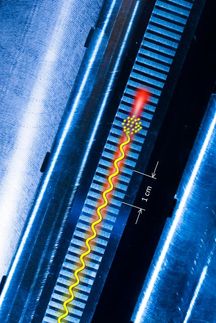Chemical element 114: A first at GSI
One of the heaviest elements
At GSI Helmholtzzentrum für Schwerionenforschung, an international team of scientists succeeded in the observation of the chemical element 114, one of the heaviest elements created until now. The production of element 114 is very difficult and requires dedicated particle accelerators. So far, this feat was achieved at only two other research centers, in the USA and Russia. In the experiment at GSI, scientists employed the innovative new setup TASCA (TransActinide Separator and chemistry Apparatus), which was developed in the past few years. The aim of future experiments with this new setup is to advance to yet heavier elements and possibly to discover new elements beyond element 118.
With the new TASCA setup, the research team led by Christoph Düllman observed 13 atoms of element 114 during the course of their four week long experiment. Despite being a small number of atoms, it corresponds to the highest ever measured production rate for element 114. This paves the way for future in-depth chemical, atomic, and nuclear physics studies. Based on the radiation emitted during the element's decay, the scientists were able to identify two different isotopes of element 114 with the mass numbers 288 and 289. The measured half-lives are of the order of one second.
"TASCA is currently the world's most efficient system for detecting superheavy elements produced with particle accelerators. This high efficiency is the key to future experiments, where we will also conduct chemical analyses of superheavy elements in the vicinity of element 114, to determine their correct position in the periodic table of the elements", says Christoph Düllmann from GSI, head of the collaboration. Düllmann also works at the newly founded Helmholtz Institute Mainz, based at Johannes Gutenberg University Mainz.
Using the 120-meter long GSI particle accelerator, the scientists fired charged calcium atoms (called calcium ions) onto a plutonium-coated foil. In the course of the experiments, a calcium and a plutonium nucleus undergo fusion to form a nucleus of the new element. The element's atomic number (the number of protons in the atomic nucleus) is 114, hence its preliminary name "element 114". Its atomic number corresponds to the sum of those of the reacting elements: calcium with 20 and plutonium with 94 protons.
The gas-filled separator TASCA separated the atoms produced by the accelerator with high selectivity from other reaction products. The atoms of element 114 then implanted into a special semiconductor detector, where they were subsequently identified based on the radiation emitted during their decay.
Initial reports on the observation of element 114 were published about 10 years ago from the research center in Dubna, Russia. However, the commission of the International Union of Pure and Applied Chemistry (IUPAC) in charge has not yet officially recognized the discovery claim. Almost simultaneously to the GSI experiment, two atoms of element 114 were observed at a research center in Berkeley, USA. The results from GSI, Darmstadt, and Berkeley, USA now essentially confirm the results from Dubna.
Recently, IUPAC officially recognized element 112, discovered at GSI, as the heaviest element thus far. Russian reports on the creation of elements up to atomic number 118 are yet unconfirmed.
Most read news
Other news from the department science

Get the chemical industry in your inbox
By submitting this form you agree that LUMITOS AG will send you the newsletter(s) selected above by email. Your data will not be passed on to third parties. Your data will be stored and processed in accordance with our data protection regulations. LUMITOS may contact you by email for the purpose of advertising or market and opinion surveys. You can revoke your consent at any time without giving reasons to LUMITOS AG, Ernst-Augustin-Str. 2, 12489 Berlin, Germany or by e-mail at revoke@lumitos.com with effect for the future. In addition, each email contains a link to unsubscribe from the corresponding newsletter.

























































